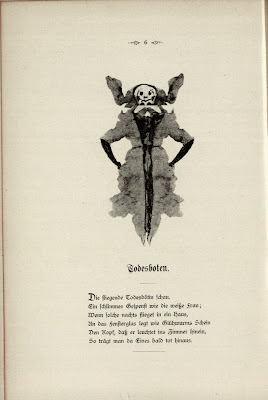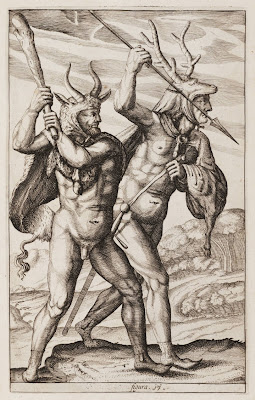
Technical illustrations and cutaways © George Ladas
(along the same lines as the incredible array from Kevin Hulsey).
(along the same lines as the incredible array from Kevin Hulsey).

German poet, doctor and supernaturalist Justinus Kerner's intriguing book of poetry and ink blots called 'Kleksographien' from Universitätsbibliothek Heidelberg {1890} (click 'titleblatt' then the '-' character at the top of the page to get thumbnail images) [via Klaus Graf]


The above two images are of four non-consecutive pages from the youngest known Masoretic Peshitta - the traditional version of the Jewish bible rendered into the Syriac language. The manuscript [Medeltidshandskrift 58], from Sweden's St Laurentius Digital Manuscript Library at Lund University, comes from Tikrit in Syria and was produced at the beginning of the 13th century. [page bottom right is a calendar]

"The Isles of Montréal as they have been surveyed by French Engineers." 1761

'Canadien and Canadienne' C. 1761
Both the above images come from 'Montréal, 500 Years of History in Archives' - "the condensed version of the first edition of Brève histoire de Montréal, by the historian Paul-André Linteau, containing over 700 archival documents"

Frontispiece and titlepage from French jurist Jean Bodin's 1693 'Dæmonomania'- a handbook for judges at witch trials - among the Historical Books at the University and State Library Saxony-Anhalt. "..to punish with the utmost rigor the witches.." [short excerpts]

Allegorical frontispiece from an otherwise unremarkable 1649 play by Sigmund von Birken - 'Krieges und Friedens bildung' (~Teaching War and Peace) - somewhere in HAB. The evil looking 'witches' on either side of the group caught my eye.

'Der Bapstesel zu Rom'
Said to have been originally by an unknown Italian artist, the 'Pope-donkey of Rome'* was meant to portray a monster allegedly discovered in the Tiber river in Rome, in 1493. The above image comes from a Reformation satire (book or pamphlet) published by Phillip Melanchthon and Martin Luther in 1523 mocking Pope Alexander VI. The title of the work is 'Deuttung der czwo grewliche(n) Figuren Bapstesels czu Rom vnd Munchkalbs zu Freyberg ynn Meysszen funden'. Image from Cornell University Rare Books. There is a second deformed monster that can be seen here.

This excellent array of demonic images are to be found in the first book by a Mexican to be published in Europe. 'Rhetorica Christiana' by Franciscan missionary Diego Valadés {1579} gives a first hand account of evangelical education in Mexico. Acknowledging the difficulties of teaching complex religious ideas across such a great cultural divide, Valadés was an advocate for creating visual keys - pictographs and glyphs similar to traditional Aztec symbols - to improve the quality of religious communication. These images come from Yale University's Beinecke Library (there are more - search on 'Valadés'). A quick way to see the whole set of images from this book is from this page and the next, which includes some descriptive commentary (the parent site - at California State University - has a series of 16th century Mexican book/manuscript images).

From 'Lustige Gesellschaft' (The Merry Company) {1867} by German author and illustrator, Franz Graf von Pocci at webgerman. Coincidentally, there is a current exhibition of Pocci's work on for a few more weeks at the Bavarian State Library (english).

Hermes Bird is from Elias Ashmole's* collection of poems by hermetic philosophers from the 1652 alchemy compendium, 'Theatricum Chemicum Brittanicum'*. The image was hooked from PBA Galleries but I later found the book digitised at CETI (University of Pennsylvania). The whole poem is transcribed at Levity but the archaic language still had me moving my lips when I read it.

'Everything is Vanity', a mezzotint by German artist Johann Jakob Haid (who worked with Johann Ridinger on a botanical series, just by the by). {undated but ~1750} The image comes from the Old Master Prints at NYPL.

I clipped this image in passing through a mostly unexplored exhibition site from the Lilly Library at Indiana University Bloomington - The world Awheel: Early Cycling Books.

{I am still quite vague about this} I *think* that in the 19th century a vast library of manuscripts ['Khizana of Lmuhub'] written in berber/arabic was established in some form or other in the Kabylie region of Northern Algeria by Sheik Lmuhub Ulahbib. The thousand or so manuscripts which were *I think* produced over a millennium covered everything from sex education, botany, astronomy, mathematics, medicine and law etc. About half of the collection was destroyed in a war in 1957 and the rest was buried for safekeeping by the custodial heirs and was not rediscovered until about 1994. Consequently, there are now only about 200 full manuscripts left and the rest are either in pieces or in some parlous state of decay. There is nothing online in english (although I was sure I read a short paragraph somewhere the other day, but I can't re-find it). The image comes from this site (with a few more manuscript pages). More (in French): i, ii, iii, iv - Italian pdf.



A 16th century Persian Koran (BSB Cod.arab.9) from the Asian Manuscript Collection at the Bavarian State Library (click 'miniaturansicht' for thumbnails) The top image above is the front and back covers and the final double page image is approximately the style of most of the rest of the 500+ leaves of this work.

Foliate Heads II
1953 lithograph by John Piper (© Piper Estate)
"The figures exhibited here are some of the earliest so titled by the artist and are derived from the idea or image of the Green Man, perhaps the most common mediaeval decorative motif, a striking and mysterious subject to which Piper returned throughout his life. It also recalls the figures of the commedia dell’arte—who, incidentally, appeared on Picasso’s drop curtain for the première of Satie’s 1917 ballet also entitled Parade."1953 lithograph by John Piper (© Piper Estate)
The image comes from the Britten-Pears Foundation gallery: it contains quite an extensive array of artworks from exhibitions that were inspired by or are in some way connected to the collaborative 20th century British partnership of composer Benjamin Britten and tenor Peter Pears.



Images of ancient German barbarians from Philipp Cluver's 'Germaniae Antiquae Libri' from 1616 [Yale University's Beinecke Library: search on 'cluver'; one other image] {small piece from Cambridge University}


Images from 'A christall glasse of Christian reformation : wherein the godly maye beholde the coloured abuses vsed in this our present tyme' collected by Stephen Bateman, minister. Imprinted at London : By John Day dwelling ouer Aldersgate, 1569. More great bafflingly obscure language. [Yale University's Beinecke Library: search on Call Number '1975 381'; quite a few more images]

'Ducatus Carniolae et Histriae una cum Marcha Windorum' by Wolfgang Lazius, 1549.
The map (shame it's not bigger) contanined within a double-headed eagle seems to be centred around the modern Croatia/Slovenia border. Found among the antique maps at the National Library of Croatia.
A religious mnemonic device* from 'Exercitia spiritualia', an illustrated edition of the Spiritual Exercises of Saint Ignatius of Loyola*.
"Each of the five fingers stands for one step in the examen conscientiæ, that is, (1). praying for grace; (2). praying the Holy Ghost; (3). examination; (4). contrition and (5). resolution (defeat of the evil). All of them are represented each time by a tiny human figure either bending on her knees or brandishing a sword. On the palm of the hand it reads “Anima mea in manibus meis semper,” a quotation from Ps.119:109 (number 118 in the Vulgata). The whole verse reads “I hold my life in my hands continually, but I do not forget your law,” and it epitomizes the content of Psalm 119—the longest one in the Psalter—which is aptly a quiet meditation on the law of God. This was a particularly significant passage on which to meditate, given the Jesuit formulation of justification through human will."
From a 1920s/1930s Polish children's book entitled 'W karainie karzelków' (In the Country of Little People) with nonsense verse by Cz. Kedzierski and only the monogram of AsO to identify the illustrator. There is a collection of about ten of these wonderful illustrations. Thanks very much to Tomasz for sharing these last two images.
Other things...
- A History of Social Dance in America from the American Antiquarian Society (I've hardly looked yet) [via Textual Studies]
- 'Lezende Vrouwen in de Kunst' (Women reading, in artworks) from Boekgrrls of course - bibliophilic voyeurism. [via Serendipities]
- Plep is in New York for a few months.
- 'The Apothecary’s Chest: Magic, Art & Medication' - a one day academic conference in November at the University of Glasgow: I don't usually post about tertiary education but I think this call for papers falls well within the ambit of materia obscura.
No comments:
Post a Comment
Comments are all moderated so don't waste your time spamming: they will never show up.
If you include ANY links that aren't pertinent to the blog post or discussion they will be deleted and a rash will break out in your underwear.
Also: please play the ball and not the person.
Note: only a member of this blog may post a comment.